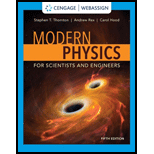
Concept explainers
(a)
The fraction of the alpha particles that is scattered between
(a)
Answer to Problem 51P
The fraction of the alpha particles that is scattered between
Explanation of Solution
Write the expression for number of alpha particles scattered.
Here,
Write the expression to find the frequency between
Conclusion:
Substitute
Substitute
Substitute
Thus, the fraction of the alpha particles that is scattered between
(b)
The ratio of alpha particles scattered through angles greater than
(b)
Answer to Problem 51P
The ratio of alpha particles scattered through angles greater than
Explanation of Solution
At two different angles, everything will remain same except the angle, so the ratio of the number of
Conclusion:
Substitute
Substitute
Thus, the ratio of alpha particles scattered through angles greater than
Want to see more full solutions like this?
Chapter 4 Solutions
MODERN PHYSICS F/SCI..-WEBASSIGN(MULTI)
- An accelerating voltage of 8 keV was used for the EDX (Energy dispersive x-ray analysis) analysis of a thin film. Approximately what accelerating voltage should be used for the EDX analysis of a bulk sample of the same composition as the thin film?arrow_forwardThe mean free path length of a 0.7-MeV photon in lead is closest to which of the following? (a)0.1039 cm (b)0.6697 cm (c)0.7038 cm (d)1.1394 cm (e)0.8776 cmarrow_forwardA beam of 8.0-MeV - particles scatters from a thin gold foil. What is the ratio of the number of ∝ particles scattered to angles greater than 1° to the number scattered to angles greater than 2°?arrow_forward
- A beam of 7.7-MeV a particles scatters from a gold foil of thickness o 0.32 μm. (a) What fraction of the a particles scattered between 1.0° and 2.0⁰? (b) What is the ratio of a particles scattered through angles greater than 1.0° to the number scattered through angles greater than 5.0°? Greater than 90°?arrow_forwardIn an experiment done by scattering 5.5-MeV ∝ particles from a thin gold foil, students fi nd that 10,000∝ particles are scattered at an angle greater than 50°. (a) How many of these particles will be scattered greater than 90°? (b) How many will be scattered between 70° and 80°?arrow_forwardFind the fraction of 7.7-MeV α particles that is deflected at an angle of 90° or more from a gold foil of 10 -6 m thickness.arrow_forward
- A. If the position of a chlorine ion in a membrane is measured to an accuracy of 1.50 µm, what is its minimum uncertainty in velocity (in m/s), given its mass is 5.86 10-26 kg? B. If the ion has this velocity, what is its kinetic energy in eV? (Compare this with typical molecular binding energies of about 5 eV.)arrow_forwardA solid metal sphere emits 1.42 ✕ 1020 photons every second with a radiating power of 2.53 W. (a)Determine the energy associated with each photon. eV (b)Assuming the sphere's power output is associated with the peak wavelength, determine the temperature of the sphere at which this wavelength is emitted. Karrow_forwardIf the radius of a calcium ion is 0.22 nm, how much energy does it take to singly ionize it? Give your answer in electron-volts (eV) with precision 0.1 eV. Give your answer to 2 significant digits.arrow_forward
- The average energy of a photon in a pulsed laser beam is 2.39 eV, with a minimum uncertainty of 0.0155 eV. Each pulse has an average of 5.00 x 1012 photons. Find (a) the time duration of each pulse, (b) the wavelength of the light, and (c) the energy per pulse in J.arrow_forwardWhat is the kinetic energy of each electron in a beam of electrons if the beam produces a diffraction pattern of a crystal which is similar to that of a beam of 1.00 eV neutrons? (knowing that electron mass is 9.11*10^-31 kg and neutron mass is 1.67*10^-26 kg). What are the specific equations that are being used in this problem?arrow_forwardCalculate the fraction per mm2 area of 7.7-MeV α particles scattered at 45° from a gold foil of thickness 2.1 x 10 -7 m at a distance of 1.0 cm from the target.arrow_forward
 College PhysicsPhysicsISBN:9781305952300Author:Raymond A. Serway, Chris VuillePublisher:Cengage Learning
College PhysicsPhysicsISBN:9781305952300Author:Raymond A. Serway, Chris VuillePublisher:Cengage Learning University Physics (14th Edition)PhysicsISBN:9780133969290Author:Hugh D. Young, Roger A. FreedmanPublisher:PEARSON
University Physics (14th Edition)PhysicsISBN:9780133969290Author:Hugh D. Young, Roger A. FreedmanPublisher:PEARSON Introduction To Quantum MechanicsPhysicsISBN:9781107189638Author:Griffiths, David J., Schroeter, Darrell F.Publisher:Cambridge University Press
Introduction To Quantum MechanicsPhysicsISBN:9781107189638Author:Griffiths, David J., Schroeter, Darrell F.Publisher:Cambridge University Press Physics for Scientists and EngineersPhysicsISBN:9781337553278Author:Raymond A. Serway, John W. JewettPublisher:Cengage Learning
Physics for Scientists and EngineersPhysicsISBN:9781337553278Author:Raymond A. Serway, John W. JewettPublisher:Cengage Learning Lecture- Tutorials for Introductory AstronomyPhysicsISBN:9780321820464Author:Edward E. Prather, Tim P. Slater, Jeff P. Adams, Gina BrissendenPublisher:Addison-Wesley
Lecture- Tutorials for Introductory AstronomyPhysicsISBN:9780321820464Author:Edward E. Prather, Tim P. Slater, Jeff P. Adams, Gina BrissendenPublisher:Addison-Wesley College Physics: A Strategic Approach (4th Editio...PhysicsISBN:9780134609034Author:Randall D. Knight (Professor Emeritus), Brian Jones, Stuart FieldPublisher:PEARSON
College Physics: A Strategic Approach (4th Editio...PhysicsISBN:9780134609034Author:Randall D. Knight (Professor Emeritus), Brian Jones, Stuart FieldPublisher:PEARSON





